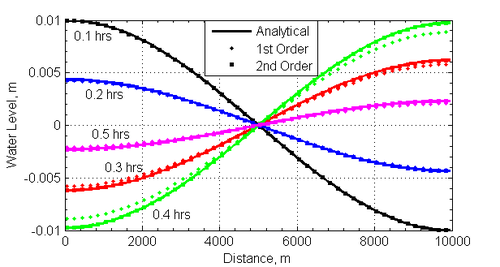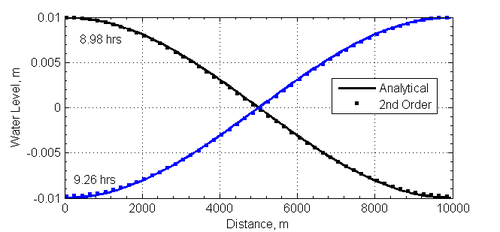Standing wave in a rectangular basin: Difference between revisions
No edit summary |
|||
| Line 38: | Line 38: | ||
The temporal tem is approximated by | The temporal tem is approximated by | ||
{{Equation|<math> \frac{\partial \phi}{\partial t} = \frac{(1+0.5\theta)\phi^{n+1} - (1-\theta)\phi^n +0.5\theta\phi^{n-1}}{\delta t} </math>|6}} | |||
where | where <math> \theta </math> is a weighting factor between 0 and 1. For <math> \theta </math> = 0, the scheme reduces to the first-order backward Euler scheme, and with <math> \theta </math> = 1, the scheme reduces to the second-order backward scheme (Ferziger and Peric 1997). | ||
The model setup is summarized in Table 1. | The model setup is summarized in Table 1. | ||
| Line 69: | Line 69: | ||
<br style="clear:both" /> | <br style="clear:both" /> | ||
= Results = | = Results and Discussion = | ||
[[File:slosh_snaps.png|right|thumb|500px| Figure 2. Water level profiles at different times for the sloshing test case calculated with the first and second order temporal schemes.]] | [[File:slosh_snaps.png|right|thumb|500px| Figure 2. Water level profiles at different times for the sloshing test case calculated with the first and second order temporal schemes.]] | ||
Revision as of 14:17, 18 April 2013
Purpose
The sloshing test case is useful for testing the model numerical dissipation for different temporal schemes. It is noted that the analytical solution uses the linear shallow water equations which assume that the wave amplitude is much smaller than the water depth.
Problem
Assuming no Coriolis, bottom friction, advection, diffusion, and that the water elevation is much smaller than the water depth, the governing equations are given by
| (1) |
| (2) |
where
- = time [s]
- = horizontal coordinate [m]
- = current velocity [m/s]
- = water depth [m]
- = water level with respect to the Still Water Level (SWL) [m]
Eliminating the velocity from both equations leads to the classical wave equation
| (3) |
Given a closed rectangular basin of length and width , the following solution can be found for simple harmonic motion (Lamb 1945)
| (4) |
where is the wave number (eigenvalue), with , is the wave frequency, and is the wave (eigen) period given by
| (5) |
When the solution is referred to as the fundamental mode. The fundamental mode is the solution used here.
Model Setup
The model domain is 1000 m long and 300 m wide. The computational grid is shown in Figure 1. The grid has a constant grid spacing of 100 m.
The temporal tem is approximated by
| (6) |
where is a weighting factor between 0 and 1. For = 0, the scheme reduces to the first-order backward Euler scheme, and with = 1, the scheme reduces to the second-order backward scheme (Ferziger and Peric 1997).
The model setup is summarized in Table 1. Table 1. Summary of the model setup for the sloshing test case.
| Model Parameter | Value |
|---|---|
| Water depth | 10 m |
| Wave amplitude | 1 cm |
| Time step | 18 s |
| Simulation duration | 10 hrs |
| Ramp period | 0 s |
| Grid resolution | 100 m |
| Advection | Off |
| Diffusion | Off |
| Bottom friction | Off |
| Temporal scheme | 1st and 2nd order |
Results and Discussion
A time series of the water level at for both the 1st and 2nd order temporal schemes is shown in Figure 4. The 1st order temporal scheme shows significant numerical dissipation which reduces the amplitude of the standing wave. The 2nd order temporal scheme shows much less numerical dissipation and agrees much better with the analytical solution.
References
- Ferziger, J. H., and Peric, M., 1997. Computational Methods for Fluid Dynamics, Springer-Verlag, Berlin/New York, 423 p.
- Lamb, H., 1945. Hydrodynamics, 6th ed., Dover, New York, 738 p.
- Mei, C.C., 1992. The Applied Dynamics of Ocean Surface Waves, World Scientific, London, 740 p.






















